Day 3 of a three day Spring Tour, our last day. It was a lovely sunny day with wall to wall blue skies. It was still cool though, in the nagging blustery NE wind, but warm out of it – hard to know how many layers to wear! We spent the day again along the North Norfolk coast.
Our first stop was at Wells Harbour. As we walked up onto the seawall, we could see all the gulls on the outer harbour sandbank, lots of Herring Gulls and a few Lesser Black-backed Gulls. We walked down to the top of the old slipway. Looking out across the sands, we couldn’t see very much – a few Oystercatchers, one or two Curlew. Two Great Crested Grebes were diving in the channel. Three Common Gulls were on the mud over by the beach.
Looking into the sun, we noticed a roost of waders further round, low down along the water’s edge, presumably out of the wind. We walked down to the old lifeboat station to look through them. They were mainly Oystercatchers, with one much paler aberrant bird in amongst them, probably leucistic.

One Bar-tailed Godwit was asleep on the front edge of the Oystercatchers and a small flock of Dunlin jostled up through the group and settled down in the seaweed behind. Three Greenshank flew in and landed on a pool up on the mud behind. Then three more Bar-tailed Godwits appeared. We could see a shape out in the haze over the dunes which looked like a bird perched on an old fishing crate – could it be the regular Peregrine? It was too far and too hazy to say unfortunately.
We were just about to go, when we noticed a single Eider asleep on the far side of the channel, with a smaller group of Oystercatchers further down the harbour. A 1st summer drake, we got it in the scope and could see its distinctive bill before it went back to sleep.

We were about to go again, but as we moved round the corner we saw more waders had been hidden from view up the harbour channel behind us. There were lots more Bar-tailed Godwits here and a few Knot roosting in with them on a sandbar. We could hear Mediterranean Gulls calling over the harbour too.
Eventually, we managed to get away without further distractions and drove round to Holkham. With no rain here for a while now, the grazing marsh is starting to dry out in places. There aren’t as many waders here now, but scanning across we did find one or two lingering Pink-footed Geese. We compared them with some nearby Greylag. Two Barnacle Geese flew over calling.
As we set off west along the track on the edge of the pines, we could hear Chiffchaffs and Blackcaps singing in the trees. We heard the song of a Willow Warbler and stopped to listen to the sweet descending scale, the true sound of spring. A couple of times, it started off with a couple of chiffs and chaffs, a little bit of mixed singing, not uncommon sometimes in Willow Warblers, particularly along here.
There were a few tits in the trees too, Blue Tits, Long-tailed Tits and one or two Coal Tits. We stopped to watch a Treecreeper climbing up the trunks of some pines by the path, and a Goldcrest was singing overhead.
It was fairly sheltered from the wind here, and warm now with the sun out. There was a nice selection of butterflies out – lots of Speckled Wood, several Orange Tip and Holly Blue, and a selection of whites. A Chocolate Mining Bee landed on the path ahead of us before it was flushed by a couple of dogwalkers who walked across right in front of us.
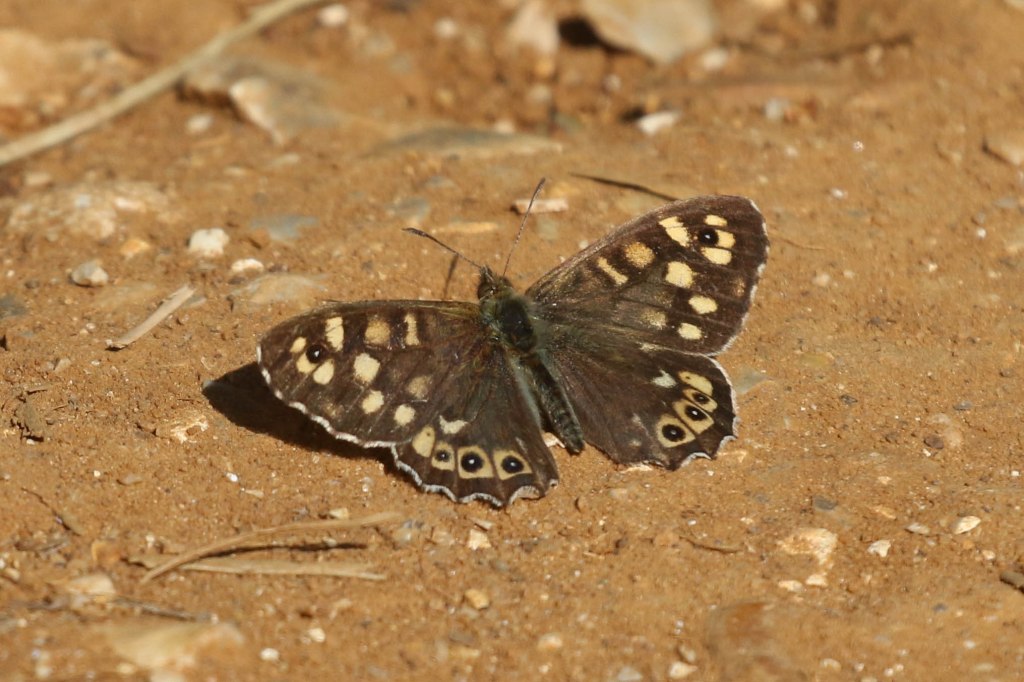
We stopped at Salts Hole. A pair of Tufted Ducks was out on the water, along with more Greylags and a couple of Mallard. We could hear a Marsh Harrier calling high over the trees, and more Marsh Harriers further back over the reedbed. A Sparrowhawk flew off over the grazing marsh.
Continuing on, there were more Chiffchaffs singing, and one in the trees over the path flew into a nearby holm oak where we watched it gleaning insects from the underside of the leaves. There were more Sedge Warblers singing in the reeds in front of Washington Hide and a Reed Warbler too, which remained stubbornly down out of view.

We walked up the Washington Hide boardwalk for a better view over the grazing marshes. There were lots of Marsh Harriers up, with some chasing, talon-grappling. One male was displaying way up in the sun, calling – possibly the same one we had heard a couple of minutes earlier.
Scanning over the grass, we found a distinctly odd-looking goose on the grazing marsh. It was with three Barnacle Geese and was a hybrid, possibly Ross’s Goose x Barnacle Goose. These Barnacle Geese are feral birds which breed in Holkham Park. A Great White Egret flew out of the back of the reeds, and landed further back before walking down into a nearby ditch. A Raven appeared briefly in front of the trees at the back.
Long-tailed Tits, Wren. Raven briefly over trees at back, but dropped down.
Continuing on west, we stopped next at Joe Jordan Hide. Six Spoonbills were out on the big pool, bathing and preening. One flew in and landed in the closer pool, then started feeding, sweeping its bill back and forth in the shallows. There was a steady change over of Spoonbills, with birds flying up into the trees, some taking nest material with them, and more dropping down to the pools.
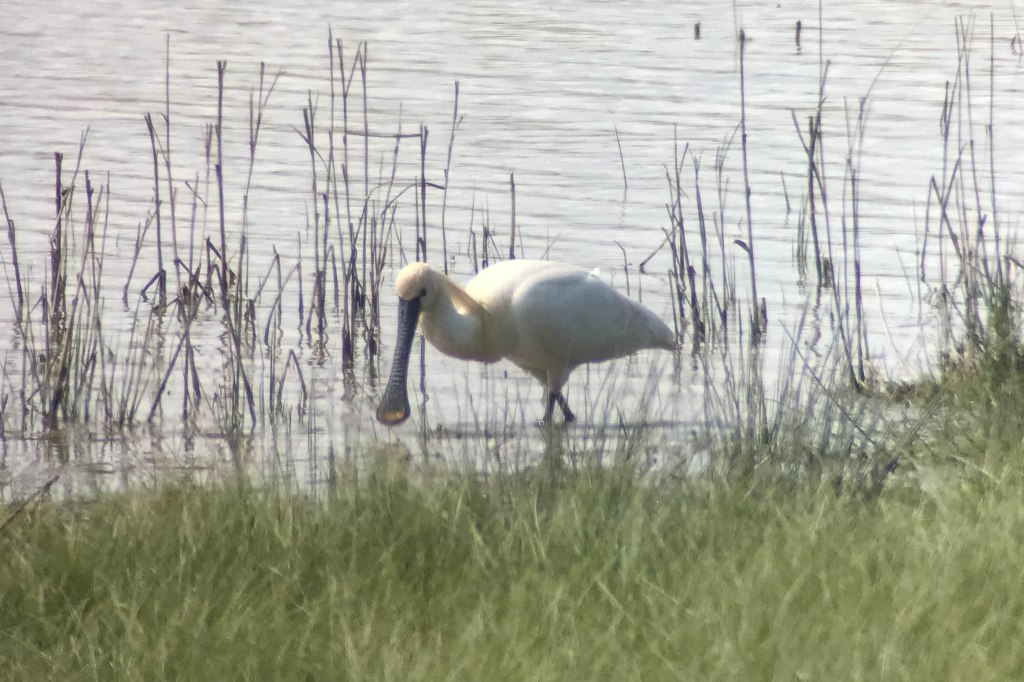
A big herd of cows was out on the grazing marsh away to the west and we could see two white birds walking around between them – Cattle Egrets. Two Great White Egrets came up briefly further back, but dropped down behind the reeds. There were a few Egyptian Geese out on the grazing marsh too.
As we walked back, a Cetti’s Warbler perched up briefly in the brambles just beyond Meals House. We were just past Washington Hide when we heard a Grasshopper Warbler reeling behind us. It sounded like it was close to path, so we scanned the bushes and walked back up the boardwalk to scan the reeds, but we couldn’t see it and then it went quiet.
It was time for lunch when we got back to the Lookout. After lunch, we drove back round to the pools at Wells. A large flock of Brent Geese was in the field opposite where we parked, feeding on the spring barley, ignoring the nearby scarecrow. A male Marsh Harrier was feeding on something on the ground at the back. A Spoonbill flew over, heading west, probably back towards the colony. A Sedge Warbler singing perched up nicely in a nearby elder. There were chipping House Sparrows in the brambles.
In the field the other side of the car park, we could see a shape hunched down in the tramlines looking a bit like a stone. It was a Grey Partridge. We had a good look at it through the scope, before it crept into the crop and worked its way slowly back away from us.
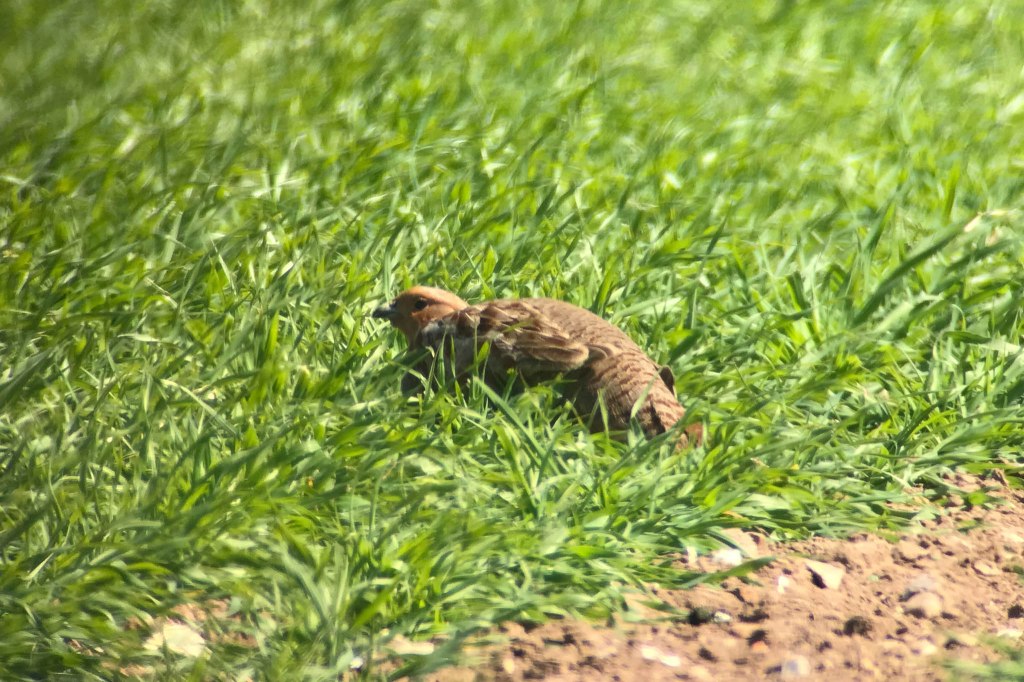
A Brown Hare was hunkered down behind a rush tussock, and several Common Snipe were feeding around the shallow pools beyond. Two Red Kites and a Marsh Harrier were now hanging in the air over the pig fields inland.
There were several Lapwings displaying. We could hear their unique song as soon as we got out of the minibus – what a sound. We watched them flying back and forth, twisting and tumbling, turning upside down. Stunning!
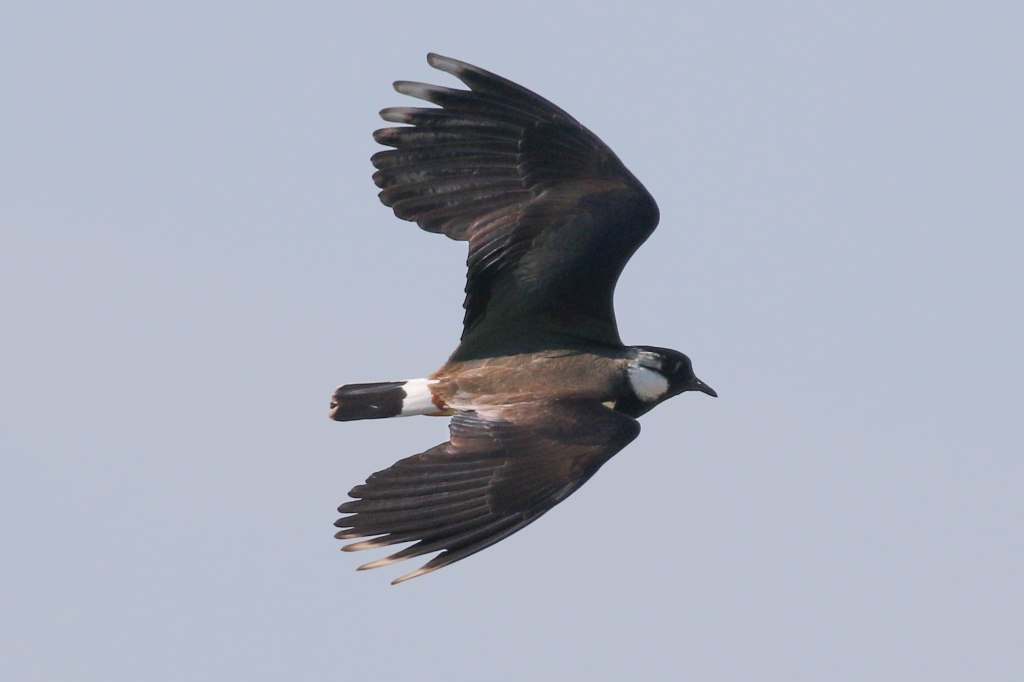
Looking down along the fenceline to the east, a male Wheatear appeared on a fence post. It kept dropping down to the edge of the field below, before flying back up, and then it flew to the gate by the cattle pens in front of us.
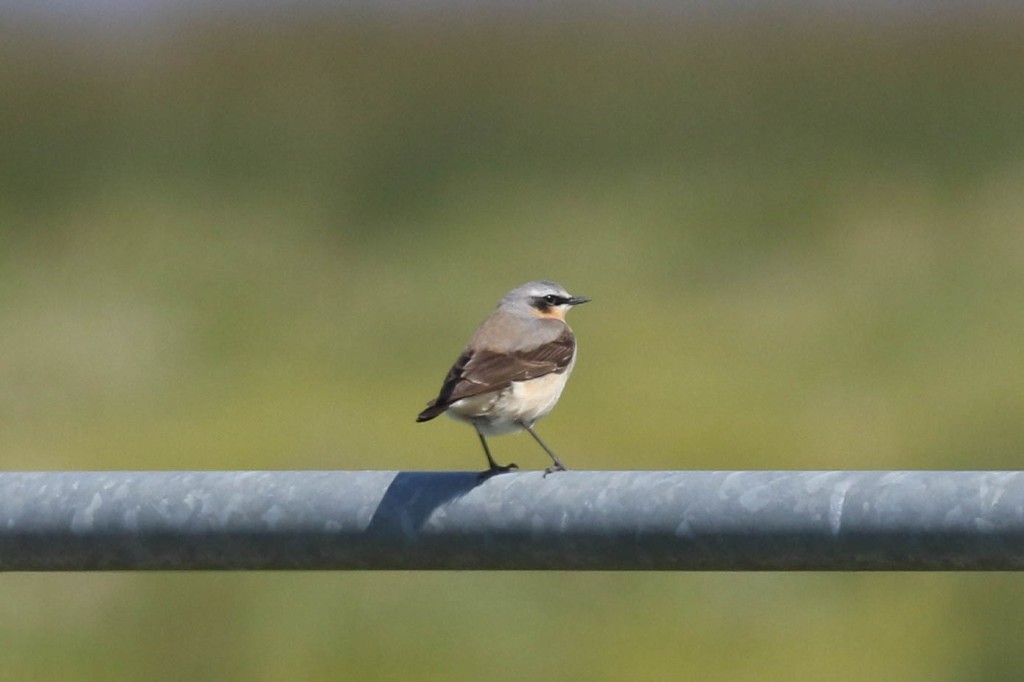
We walked down the track, and continued scanning the pools either side. There was a nice selection of ducks – Shoveler, Gadwall, Teal and Shelduck. There were more Avocets and gulls further back.
There are lots of Common Snipe here still, but having seen a Jack Snipe too here a few days ago, we kept scanning round the edges of the rushes. As if by magic, a Jack Snipe appeared. It was only out for a couple of seconds, then ran back in, but at least we knew where it was now. We continued to watch and after a minute or so it came out again. We watched as it worked its way along the edge, in and out of the rushes. At one point, it was in the same view as a Common Snipe, giving a good size comparison.

When the Jack Snipe disappeared back into the rushes, we decided to move on. We drove along the coast to Stiffkey Fen. As we walked in along the permissive path, there were Blackcaps and Chiffchaffs singing in the copse by the road. Down by the river, a Kestrel flew off the telegraph post as we emerged from the trees. When we got to the point where we could see over the brambles to the Fen, a Kingfisher shot off from the reeds by the sluice.
There has been a Dusky Warbler along here, but we had cautioned that we were unlikely to see it – it is very skulking, it was not a good time of day for it, and people have spent 5 hours here waiting to see it. But as we walked along the narrow path by the sallows, we heard it call and watched as it flew out of the hedge ahead of us. It disappeared into the thickest sallows the other side, but we could still see it moving through the tangled branches above the river. We tried to follow it, but after a while it disappeared.
We continued on, up onto the seawall. The tide was going out, and there were lots of gulls on the Fen. There weren’t many waders here now, but we did find a Green Sandpiper on the edge of the reeds. A couple of Ruff were chasing each other round the edge of the islands. From a little further up along the seawall, we could see a single Spoonbill on the Fen, feeding in the shallow water behind the reeds.

It is a great view from here, looking across Blakeney Harbour to the Point beyond. We could see Sandwich Terns in the distance. Several groups of Brent Geese were feeding on the saltmarsh and we found a Whimbrel here too. It was hard to see at first, disappearing into the tall vegetation, but eventually everyone got a good look through the scope.
It was more exposed to the wind here and cooler up on the seawall, and it was time to head back too, so we decided against walking further round. As we walked back along the footpath by the river, the Dusky Warbler flew out of the hedge ahead of us, calling, and disappeared through the sallows.
A nice bird, and a nice location, to wrap up the trip.
















